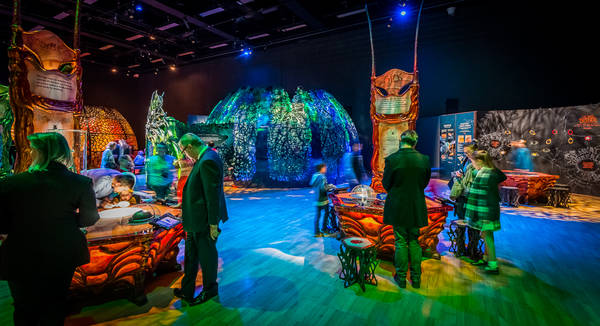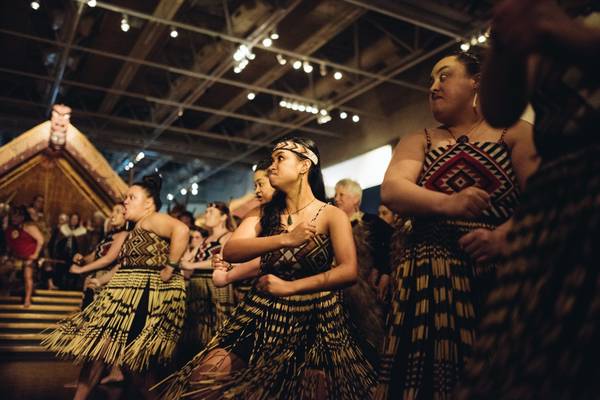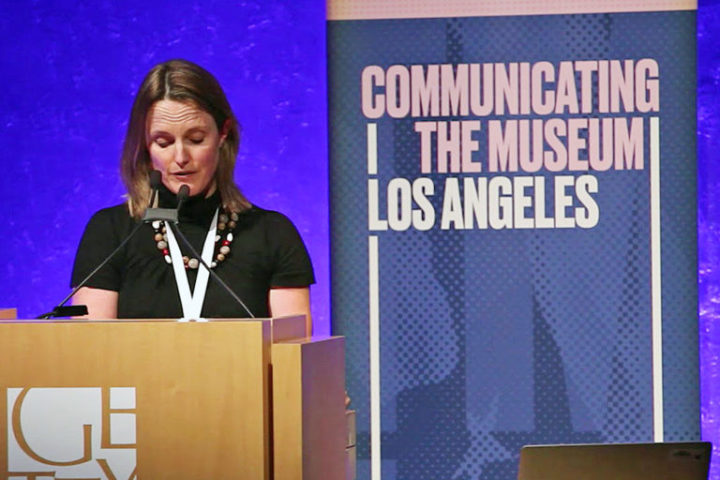The latest edition of international arts communication conference Communicating the Museum, organised by Paris-based cultural communications agency Agenda, will take place in Los Angeles, US, from 6 to 9 November 2017. Professionals from an array of museums will gather for discussions around the theme Museums Beyond Walls, analysing trends and sharing best practices. Frith Williams, Head of Exhibitions at Te Papa, New Zealand’s bicultural, multidisciplinary national museum, is one of the featured keynote speakers, and took the time to answer a few of our questions leading up to the conference.
Could you tell us about your own path to Te Papa, and within the museum? What has been a defining experience for you in your audience engagement work?
That path is a roundabout one, and personal rather than professional experiences have probably been most defining. Personally, I can relate to people feeling out of place in museums, and that helps in my work. As a kid, I loved my local museum’s re-creation of an old schoolroom – sitting at the old wooden desk, musty smell, ink and quill. Being transported through time. But otherwise I was mostly turned off by museums and art galleries. I remember sterile spaces, polite conversation, pretentious labels. The art works at home were – well, ‘at home’. In galleries, they felt cold and self-conscious, and I guess I did too.
So how have I ended up working in a museum for 13 years? Accidentally at first, as a writer after working in educational/digital publishing. Te Papa was the perfect place because it was a new kind of museum reaching a really broad audience, including young people. That resonated. At university, I studied theatre and film, and I now love similar things about museums: working in three dimensions with mixed media. I love the way the visitor can be a central character in this huge, immersive installation or story. Not even theatre or film can ‘invite you inside’ in the same way. Here, that fourth wall is already broken to some degree.
Te Papa is renowned as an accessible, creative museum that is hugely engaged with its communities and attuned to its audiences. In this context, what does ‘breaking through the fourth wall’ entail, concretely? Could you talk a bit about some of the museum’s work in that way?
There are lots of ways to think about walls in the museum – physical, as well as intellectual, emotional, cultural – and as many ways to break them, so it’s a huge team effort.
Like many big museums, we break the obvious physical walls by taking exhibitions on the road, like our latest international show Bug Lab – a collaboration with Weta Workshop about how bugs can inspire solutions to big human problems.

Bug Lab on tour at Melbourne Museum. Photograph by Stewie Donn © Te Papa
And of course we publish digitally through Collections Online and our main website, where there are some cool stories and ways to get involved – like Art Wall, which lets you ‘hang’ an art work in Te Papa’s galleries from anywhere in the world. You can have a go at art-wall.tepapa.govt.nz/. That project may tour, so the national art collection might be popping up in unlikely places.
I work in exhibition development, where breaking walls is primarily about how we collaborate, communicate, and interact with our audiences.
Te Papa was a leader in collaborating with communities, including Māori iwi (tribes) and under-represented groups, such as refugees. The museum set up dedicated galleries to house those exhibitions, like our latest iwi show, Ko Rongowhakaata. A core philosophy is mana taonga: our collections are living things that have strong ties to their places of origin. So our teams go out and spend time in those communities – as far as the tiny atolls of Tokelau – and listen to the locals talk about their taonga (treasures) and what matters to them. And those community members co-collect with our curators, and come inside the museum to work too. We’re really at their service in creating their shows. Another team, National Services Te Paerangi, is always out around the country, supporting hundreds of small, volunteer-based museums to care for and interpret their taonga.

Opening of the exhibition Ko Rongowhakaata, a collaboration with the Rongowhakaata iwi (tribe). Photograph by Tim Onnes © Te Papa
Right now, we’re redeveloping all our long-term shows, and we’re trying to break some walls there too. We’ve been doing audience testing right around the country to capture New Zealanders’ views on art, environmental issues, and historical events, and that’s involved travelling to various locations. (We’re an art, natural history, and history museum rolled into one, so we work across all these fronts.) But we’re also being niftier with our audience testing on a daily basis, making quick prototypes with paper, pen, and tape. We recently tested a new extinction interactive in a local school to see how the kids would respond to touching bird skulls (mixed reaction, and surprisingly gendered), and we often take early ideas onto the museum floor. Our new Experience Designers (exhibitions) and UX Designers (digital) are helping with this.

Warming up to test an exhibition concept at Island Bay School, Wellington. Photograph by Frith Williams © Te Papa
Like a growing number of museums, we’re also exploring controversial topics much more and creating spaces for people to debate them, because we’re not the only experts. So majestic albatross and freaky deep-sea fish might be the springboard for a debate around fishing methods or plastics in the ocean. Should we ban plastic bags, like the ones in this albatross’ stomach? What about synthetic fabrics made from microplastics? It’s all about connecting the collections we hold, which might otherwise be seen as frozen in time, to issues that matter today, as well as collecting around contemporary issues.
Being able to respond as a visitor in exhibitions is valuable in its own right, of course, but what if some of those contributions – like responses to climate change – could also be useful data for researchers? If we collect those responses digitally, we’ll be better able to share them with other organisations to inform that research. So we’re exploring how we might do that.
Then there’s our recent use of a personal voice, rather than a traditional curatorial voice, not just to break down that expert/non-expert divide but also because it’s often more creative and compelling. Our international touring show Bug Lab is ‘told by bugs’, and Gallipoli: The Scale of Our War is narrated by the soldiers. Our new galleries will include some quirkier interpretations of art too, to tackle art fear.

Nurse Lottie Le Gallais model, Gallipoli: The Scale of Our War exhibition. Photograph by Michael Hall © Te Papa
As a multidisciplinary museum, we’re also able to play with the boundaries between disciplines, for example, by bringing together mātauranga (Māori knowledge) and science. So you might discover how the Māori story of Ngātoro-i-rangi and the baskets of fire overlaps with what scientists know about the volcanoes in the Pacific Ring of Fire. Related to that, we can mash up the types of activity you might expect of those disciplines. For example, we might take a really hands-on ‘science gallery’ approach to art or history – see how a kaleidoscope creates colourful patterns, or navigate a waka (canoe) to Aotearoa New Zealand – and we might get arty in our science and history shows.
Finally – and we’re back to physical walls here – we want to better connect our visitors to external places to learn and get involved, for example, to watch live performances or take part in a harbour clean-up or dig deeper online. That’s really about being a gateway onto the rest of the country – a hole in the wall, not a wall at all!
How essential is a sense of place to the Te Papa experience (i.e. familiarity with the historical/cultural context of the country but also the unique and symbolic architecture of the building, which tells stories itself and is connected to the stories being told within)? How is this transmitted (or not) in Te Papa’s virtual spaces, traveling exhibitions, and other ‘beyond the walls’ initiatives?
Our audience is around half national, half international, so we can’t assume that they know much about Aotearoa New Zealand’s environment, history, or art. We want to offer them that sense of place, and manaaki or welcome them in a uniquely New Zealand way. That’s important. As the national museum, we’re not encyclopaedic. We’re here primarily to explore what’s unique about this Pacific place – not just the familiar stories, but also some of the untold, surprising ones.
That specialness continues outside the museum through shows like Whales | Tohorā, which explores New Zealanders’ connection with whales and has been touring internationally for a decade, and public programmes like Matariki, the Māori New Year. This year, Matariki offered various opportunities beyond our walls: an outdoor ritual, online resources, classroom programmes. In line with our original motto ‘Our Place’, we also want people to bring their places into our spaces and be able to share them, for example, how they connect with their land.

People float tea lights on Te Papa’s pond, Matariki Festival (Māori New Year), 2017. © Te Papa
It’s interesting you mention the building. You’re right that it’s symbolic: one ‘face’ Māori, the other European. A marae (meeting place) that welcomes all people. Papatūānuku (Earth Mother, the natural environment) below, grounding everyone and everything. And that’s an important part of the museum’s history and identity, though it’s not necessarily obvious to people. It also raises a question about how much buildings should determine the ways that stories are told within them. Our society has changed since Te Papa opened 20 years ago. Is our past separation of Māori and non-Māori stories the way we want to move into the future? How do we represent multiculturalism today? These questions are being discussed now, as part of our renewal process. You might have to wait until our core exhibitions re-open to discover the final call.
